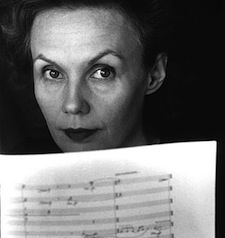I have started to rip the complete Mozart Symphonies by Christoper Hogwood, but that is 19 discs and I know that will continue into tomorrow. But I also pulled most of my Kaija Saariaho collection tonight as well. I’m not positive, but she might be the first living composer I have put onto the computer so far… partly because so much of my music by living composers is downloaded (since finding actual discs these days of this music is next to impossible) and partly because while I appreciate a good deal of it, liking it enough to have in the front layer of CDs of things is a different story. I know where Steve Reich is when I need his music for something (my own reference or for a class) but I don’t think I am just going to throw him on for an evening of listening. Kaija Saariaho is a different story though. Her symphonic works can be hit or miss in my opinion, but her chamber music can be beautiful and thrilling.
Dawn Upshaw’s performance of ‘Lonh’ is wonderful. The electronics part is wonderful. The vocal writing is wonderful. It is also so many things that most contemporary music with electronics is not – a dynamic piece that is composed on more then a single idea. Most of her work actually exhibits a large degree of dynamic change and structure that is more then the usual brick of noodling around a single concept that so much contemporary music often gets caught up in. If you have been to an ICMC or SEAMUS conference, I am sure you know exactly what I mean. The computer part in ‘Lonh’ is also not just a ‘background’ for the vocal part, but an equal partner in the piece. Again – this is something that she does particularly well. Her works for cello and electronics (‘Pres’ and ‘Petals’) are both dramatic works that grow better on repeated listening. In some ways, she is also very classical. Her work tends to be experimental while at the same time giving great credit to her listeners time, attention and memory. Her works don’t need to be studied from the score to be appreciated or enjoyed, yet they are challenging and dramatic.
As I began to work more and more with pieces and live electronics, she is someone that I think I have learned quite a bit from. And her finished pieces (and the precision she is able to create with her electronics processing) reminds me that I have LOTS of work to do still in my own learning. When I was looking at some of her works, I came across her catalog on the chesternovello.com site, and noticed something that I hadn’t really seen before (but have seen quite a bit of since): she also has downloadable versions of the computer parts for her pieces available for anyone to download. For example, after I heard ‘Lonh’ I was able to find the electronics here: http://www.chesternovello.com/documents/additional/lonh.htm. I couldn’t believe how valuable a resource something like this was, and on top of that what a great source of documentation for the work. The question of ‘what is the score’ is often a difficult one to answer when it comes to live electronics. The code / patch that makes the piece work is an important part of the score actually, and to see it freely available is a wonderful learning opportunity for young composers. I certainly don’t hold myself in her league at this point, but as I developed more and more pieces (as well as the software to run them), the idea of posting my code for anyone else to look at was something I came to believe in. Maybe someday someone will get something useful from one of my pieces as well, and as technology changes (and the computer as an instrument starts to make its way out of the stone age) perhaps some of the stuff I do now will influence what things will become. In many ways, computer music is currently at a stage of development like that of western classical music was when early notation was beginning to be used. As works were written down and disseminated a huge amount of musical development began (rhythm, polyphony, etc.) simply because others could study and build on it. It is exciting to be around at a similar time again.


